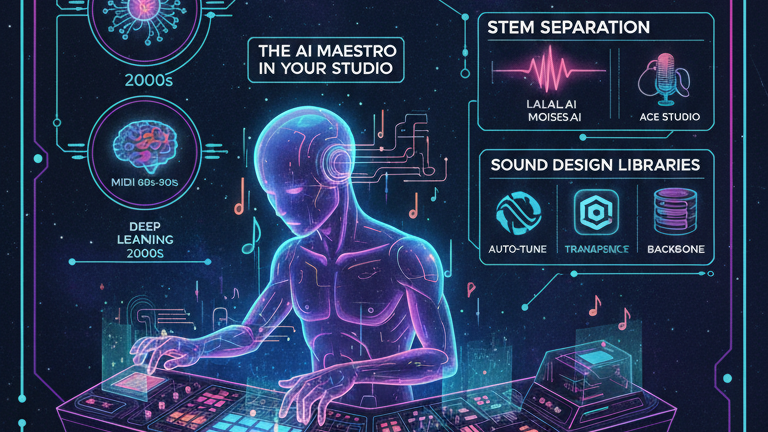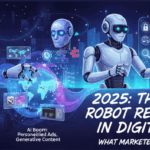I. Hook: The AI Maestro in Your Studio
Let’s cast aside the image of sterile robots churning out soulless tunes. The reality of 2025 is that AI has evolved into something far more intriguing: a co-pilot, a collaborator, an extension of your creative self within the sound production process. This isn’t some distant, sci-fi fantasy; AI tools are not only present but are actively reshaping the landscape of music creation as we speak. They’re not here to replace us but to augment, amplify, and perhaps even challenge our very understanding of what it means to make music.
II. A Quick Trip Down Memory Lane: How AI Got Its Groove
To truly grasp the significance of AI’s current role, we must first acknowledge its somewhat awkward but ultimately fascinating journey through time.
- The Early Days (Mid-20th Century): Picture this: punch cards, vacuum tubes, and the nascent dream of a thinking machine. The “Illiac Suite” (1957), often cited as one of the earliest examples of computer-generated music, wasn’t exactly chart-topping material. It was more akin to AI diligently practicing its scales, a foundational exercise in a long and complex musical education.
- MIDI & Early Intelligence (1980s-1990s): The advent of MIDI was a pivotal moment, granting computers the ability to “converse” with musical instruments. This era witnessed the emergence of David Cope’s “Emmy,” a program capable of emulating the styles of classical composers. While the results were arguably more pastiche than profound, “Emmy” offered the first tantalizing glimpse of AI possessing a discernible “style,” a hint of creative identity.
- Machine Learning & Neural Networks (Late 90s-2010s): The game began to change as AI transitioned from following pre-programmed instructions to learning from data. Sony’s “Continuator,” an interactive improvisation system, allowed AI to jam alongside live musicians, adapting and responding in real-time. In 2014, LANDR disrupted the industry by introducing AI-powered mastering. The AI was now actively listening, analyzing, and learning to refine audio.
- Deep Learning Revolution (2010s-Present): Hold on to your hats, because this is where things get truly transformative. Projects like Google Magenta, OpenAI’s MuseNet, and the rise of text-to-music platforms such as Suno and Udio have catapulted AI from a mere assistant to a potential composer, vocalist, and even marketing strategist. AI is no longer simply mimicking; it’s generating, innovating, and staking its claim in the creative process.
III. The AI Toolkit: Your 2025 Production Power-Up
Let’s delve into the specific tools that are currently empowering musicians and producers in 2025.
- Composing & Generating (Bye-Bye Writer’s Block!):
- Need a complete track seemingly conjured from thin air? Platforms like AIVA, Soundraw, Boomy, Suno, and Udio can act as your instant ensemble, generating compositions across various genres.
- Stuck searching for that elusive melody or chord progression? Amadeus Code and Orb Producer Suite can provide a spark of inspiration, nudging you toward new musical directions.
- The science-fiction dream of text-to-music is now a tangible reality. Tools like WavTool enable you to articulate your musical vision through written descriptions, translating words into audible soundscapes.
- Mixing & Mastering (The Polish & Shine Crew):
- Achieving a professional, radio-ready mix and master no longer necessitates exorbitant studio fees. LANDR Mastering, iZotope Neutron/Ozone (with their intelligent Mix/Mastering Assistants), and Cryo Mix automate intricate processing tasks, freeing you to focus on the nuances of your sonic palette.
- Focusrite Fast Bundle provides intelligent starting points for your mixes, accelerating the initial stages of the mixing process and allowing you to refine the finer details.
- Stem Separation (The Audio Dissectors):
- Ever found yourself yearning to isolate a specific element from a track, like the vocal performance? Tools such as LALAL.AI, MOISES.AI, and LANDR Stems function as audio scalpels, dissecting tracks into individual stems with remarkable precision. Ideal for crafting remixes, creating samples, or simply deconstructing existing material.
- Vocal Magic & Transformation (Sing Your Heart Out, or Let AI Do It):
- Aiming for a flawless vocal performance? Auto-Tune™ and Melodyne remain industry standards, now enhanced with the power of AI to achieve unprecedented levels of precision and expressiveness.
- Seeking expressive and realistic AI-generated vocals? ACE Studio and Dreamtonics Synthesiser V offer incredibly lifelike singing synthesis, opening up new avenues for vocal experimentation.
- Eliminate unwanted noise and artifacts from your vocal recordings with the AI-powered noise reduction capabilities of Waves Clarity Vx Pro and Accentize dxRevive Pro.
- Venture into the realm of voice cloning and deepfakes with tools like Kits AI, enabling you to emulate unique vocal tones, even mimicking the voices of celebrities. (Prepare for the ethical debates!).
- Sound Design & Effects (Sonic Sculptors):
- Generate entirely novel sounds with the innovative Synplant 2, or craft custom sound effects from textual descriptions using SFX Engine.
- Sound Doctor by Unison Audio intelligently constructs custom FX chains tailored to any sound source, streamlining the sound design process.
- DAWs with Brains (Your Studio Just Got Smarter):
- Modern Digital Audio Workstations (DAWs) such as LUNA and Mozart AI are increasingly integrating AI to automate repetitive and tedious tasks, empowering you to concentrate on the core creative aspects of music production.
- Sample Libraries & Organisation (The Digital Librarian):
- Backbone generates unique drum samples, while XO intelligently organizes your sprawling sample collection, enabling you to quickly locate the perfect sound for your project.
IV. The Elephant in the Studio: AI Music’s Controversies
The integration of AI into music production is not without its inherent controversies. These complex questions demand thoughtful consideration and open dialogue.
- “Soul” vs. Algorithm: Can AI truly capture the essence of human emotion in its creations? Hans Zimmer expresses skepticism, while Brian Eno embraces AI as a “creative partner.” Where do you draw the line between human artistry and algorithmic generation?
- Copyright Chaos: Who holds the rights to AI-generated music? The legal landscape is murky, with lawsuits already underway (Universal Music Group vs. Suno/Udio!). US courts have ruled that AI-only creations are not currently copyrightable, but human involvement can alter this equation.
- Job Fears & Market Saturation: Will AI lead to widespread job displacement for sound engineers, composers, and artists? Some studies predict a potential income decline of up to 24% for creators by 2028. Is AI democratizing access to music creation, or is it exacerbating existing inequalities within the industry?
- Deepfakes & Voice Cloning: The enactment of the “Elvis Law” in Tennessee underscores the growing concerns surrounding the unauthorized use of AI to mimic voices and likenesses. The viral spread of AI-generated tracks impersonating artists like Drake raises thorny questions about authenticity, consent, and artistic integrity.
- Homogenization of Sound: Will the reliance on AI-driven tools result in a bland, formulaic musical landscape, dictated by algorithmic trends rather than genuine artistic expression?
- Transparency is Key: Should listeners be informed when AI is involved in the creation of a song? Many argue that transparency is essential for maintaining trust, upholding ethical standards, and respecting the contributions of human artists.
V. The Crystal Ball: What’s Next for AI in Music (Beyond 2025!)
Looking beyond the horizon of 2025, we can envision even more radical transformations in the relationship between AI and music.
- Hyper-Personalized AI Assistants: Imagine a DAW that intimately understands your creative preferences, anticipating your needs and suggesting customized EQ settings, synth patches, and even your preferred brand of coffee.
- Seamless Virtual Collaborations: AI will bridge geographical divides, facilitating real-time collaborations by translating lyrics, mitigating latency issues, and proposing cross-cultural musical ideas.
- Immersive Experiences: The fusion of VR/AR technologies with AI will give rise to entirely new forms of musical expression, transforming live performances into immersive, multi-sensory experiences.
- Smart Distribution & Marketing: AI algorithms will intelligently connect your music with its target audience, suggesting relevant tags, predicting emerging trends, and optimizing your marketing campaigns.
- Ethical Evolution: The legal and ethical frameworks surrounding AI music will (hopefully) evolve to address the complex challenges outlined above, ensuring fair compensation for human artists and promoting responsible AI development. The uniquely human elements of emotion, intention, and lived experience will remain irreplaceable cornerstones of artistic creation.
VI. Conclusion: Your Musical Journey, Amplified by AI
AI is not a fleeting fad; it is a transformative force that will continue to shape the future of music. It offers unprecedented opportunities for creativity, efficiency, and accessibility, but its responsible and ethical implementation is paramount. Perhaps the most valuable “music AI tool” of 2025 will be the one that empowers you to discover your unique artistic voice, amplifying it with greater speed, clarity, and boldness than ever before. The question that remains is: What will you create?

